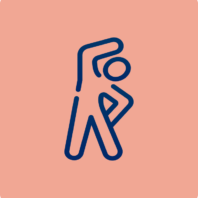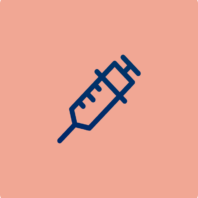What are the treatment possibilities?

Physical and occupational therapies
Physical therapy is the mainstay of treatment for spasticity. It is designed to reduce muscle tone, maintain or improve range of motion and mobility, increase strength and coordination, and improve care and comfort.
Occupational therapies address the functional difficulties of living with spasticity. They aim to allow patients to regain autonomy while recovering or help patients and carers cope with the situation. An occupational therapy approach aims to find effective solutions to problems with activities of the daily routine.




Rehabilitation and pharmacological spasticity treatments
Rehabilitation (physical and occupational therapy) and pharmacological spasticity treatments such as injection of botulinum neurotoxin are considered to work synergistically over time.
Botulinum neurotoxin injections can further facilitate rehabilitation efforts and thus improve spasticity even more. Usually, the effect of a single botulinum neurotoxin injection lasts several weeks, with an average effect duration of three months.




Other treatment options
Several other options to treat spasticity exist. Depending on the desired approach and medical conditions, the following offer a wider range of possibilities to patients.
Oral medication
The main approved oral medications include:
- Baclofen
- Cannabinoids containing tetrahydrocannabinol (THC) – approved in some countries as a spray; however, they are only indicated for moderate to severe spasticity in patients with multiple sclerosis after failure of other oral drugs
- Dantrolene – approved in some countries but due to the insufficient level of evidence, the recommendation level is low
All oral drugs have in common limited efficacy and a high rate of adverse events, mainly fatigue.
Among the oral treatments, only two (baclofen and tizanidine) have proven their efficacy in reducing spasticity on the Ashworth Scale.
Oral medications may be used in multiple sclerosis and spinal cord injury-related spasticity, especially to reduce clonus.
Intrathecal baclofen therapy
Intrathecal, meaning into the brain or spinal cord, baclofen is an effective treatment for spasticity and is recommended for people with spinal cord injury or multiple sclerosis.
It is a long-term treatment requiring continuous, intra-spinal administration via an implanted pump. Intrathecal baclofen is mainly for individuals whose spasticity of the legs is broadly distributed and sometimes extends to the torso.
People receiving intrathecal baclofen therapy need to be closely followed to maintain good therapy efficacy and avoid potential adverse events. In wide-spread spasticity, such as severe bilateral lower limb spasticity, intrathecal baclofen can be used as a first-line therapy.
Chemodenervation
Chemodenervation generally means the interruption of neural transmission by the injection of a chemical compound into target muscles, which may be:
- Short acting – the injection of local anesthetics (e.g., novocaine, lidocaine, bupivacaine), which inhibit signal transmission and are effective for minutes or hours (novocaine: 20–45 minutes, lidocaine: 1–3 hours or bupivacaine: up to 12 hours). Short-acting chemodenervation can be used to identify appropriate targets for longer-acting nerve blockade, particularly in complex cases that may involve multiple muscles that need to be treated.
- Long acting – this can be achieved with substances such as phenol, alcohol or botulinum neurotoxin injected into the affected muscle:
- Phenol and alcohol cause a nonspecific destruction of nerve and muscle tissue in the injected area. The effect lasts between one month and two years. Adverse events may include temporary or permanent pain near the injection site, as well as vascular reactions. Phenol and alcohol are second-line therapeutic options.
- Botulinum neurotoxin is a highly specific treatment causing focal and controllable muscle paresis or paralysis in the targeted muscles. Adverse effects of botulinum neurotoxin depend on the site of injection and skill of the injector; they include muscle weakness, pain, fatigue, flu-like symptoms and a dry mouth and dizziness.
Taken together, the various forms of chemodenervation can be indicated in localized and severe spasticity and to support or even facilitate other treatments such as physical therapy.
Botulinum neurotoxin
Botulinum neurotoxin is recommended as a first-line therapy for spasticity in a number of national and international guidelines.
It is part of an integrated treatment approach for post-stroke spasticity.
Botulinum neurotoxin creates a ‘window of opportunity’ for improving motor and activity performance and should be followed by physical and/or occupational therapy.
In multifocal spasticity (spasticity in more than one place), it is possible that spasticity is too extensive for full spasticity treatment with botulinum neurotoxin. This is possibly because the total botulinum neurotoxin dose exceeds the maximal approved dose or because of potential for adverse events. In such cases, a complementary pharmacological treatment such as oral treatment, surgery, intrathecal baclofen or phenol blockade may be used.
As botulinum neurotoxin is a locally acting treatment, it can specifically weaken overactive muscles that are affected by spasticity, without weakening healthy muscles.
To maximize the benefits of botulinum neurotoxin treatment for people with spasticity and to provide long-term efficacy, it has to be injected by an experienced injector who will take care notably of:
- Titration of optimal dose
- Selection of the right muscles to inject
- Ensuring that botulinum neurotoxin is injected in the selected muscle (usually performed with the support of ultrasound guidance)
Surgical interventions for spasticity
When not controllable by physical therapy, oral or intrathecal medications and/or botulinum neurotoxin injections, spasticity symptoms can be treated with selective ablative procedures, which are used to destroy abnormal tissue. In most cases, complementary neurosurgical and functional orthopedic approaches are used.
With surgical interventions, muscles can be denervated or tendons and muscles can be released, lengthened, or transferred to relieve the symptoms of spasticity.
In order to release shortened and hardened muscles, the contracted tendon is partially or completely split surgically and then the joint is repositioned at a more normal angle. A cast stabilizes the joint over a period of several weeks while the tendon regrows. After removing the cast, physical therapy is necessary to strengthen the muscles and improve the patient’s range of motion.
Another surgical intervention that is used for the treatment of spasticity is called functional or selective dorsal rhizotomy.
In this procedure, the neurosurgeon performs a rhizotomy by cutting the nerve roots. The nerve roots are the nerve fibers lying just outside the backbone (spinal column) that send sensory messages from the muscles to the spinal cord. ‘Selective’ indicates that only certain nerve roots are cut and ‘dorsal’ refers to the target nerves that are located at the back of the spinal cord (the upper surface when a person is lying on his or her stomach).


